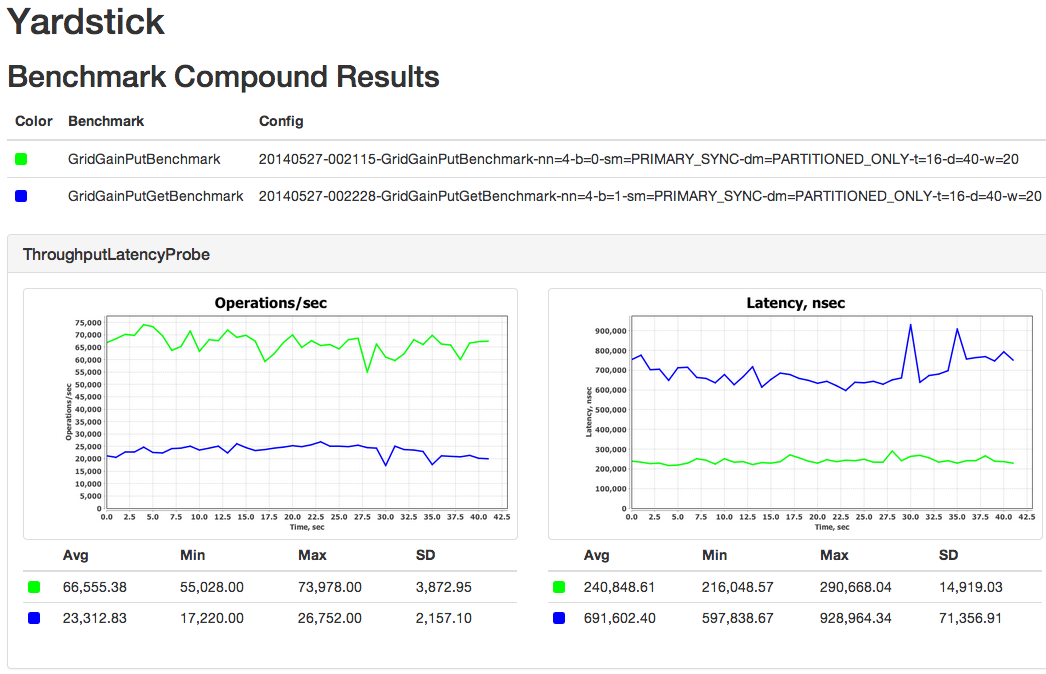Yardstick GridGain is a set of GridGain Data Grid benchmarks written on top of Yardstick framework.
Visit Yardstick Repository for detailed information on how to run Yardstick benchmarks and how to generate graphs.
The documentation below describes configuration parameters in addition to standard Yardstick parameters.
- Create a local clone of Yardstick GridGain repository
- Import Yardstick GridGain POM file into your project
- Run
mvn packagecommand
The following benchmarks are provided:
GridGainGetBenchmark- benchmarks atomic distributed cache get operationGridGainPutBenchmark- benchmarks atomic distributed cache put operationGridGainPutGetBenchmark- benchmarks atomic distributed cache put and get operations togetherGridGainPutTxBenchmark- benchmarks transactional distributed cache put operationGridGainPutGetTxBenchmark- benchmarks transactional distributed cache put and get operations togetherGridGainSqlQueryBenchmark- benchmarks distributed SQL query over cached dataGridGainSqlQueryJoinBenchmark- benchmarks distributed SQL query with a Join over cached dataGridGainSqlQueryPutBenchmark- benchmarks distributed SQL query with simultaneous cache updates
All benchmarks extend GridGainAbstractBenchmark class. A new benchmark should also extend this abstract class and implement test method. This is the method that is actually benchmarked.
Before running GridGain benchmarks, run mvn package command. This command will compile the project and also will unpack scripts from yardstick-resources.zip file to bin directory.
Note that this section only describes configuration parameters specific to GridGain benchmarks, and not for Yardstick framework. To run GridGain benchmarks and generate graphs, you will need to run them using Yardstick framework scripts in
binfolder.
Refer to Yardstick Documentation for common Yardstick properties and command line arguments for running Yardstick scripts.
The following GridGain benchmark properties can be defined in the benchmark configuration:
-nn <num>or--nodeNumber <num>- Number of nodes (automatically set inbenchmark.properties), used to wait for the specified number of nodes to start-b <num>or--backups <num>- Number of backups for every key-ggcfg <path>or--ggConfig <path>- Path to GridGain configuration file-sm <mode>or-syncMode <mode>- GridGain synchronization mode (defined inGridCacheWriteSynchronizationMode)-dm <mode>or--distroMode <mode>- GridGain distribution mode (defined inGridCacheDistributionMode)-wom <mode>or--writeOrderMode <mode>- GridGain write order mode for ATOMIC caches (defined inGridCacheAtomicWriteOrderMode)-txc <value>or--txConcurrency <value>- GridGain cache transaction concurrency control, eitherOPTIMISTICorPESSIMISTIC(defined inGridCacheTxConcurrency)-txi <value>or--txIsolation <value>- GridGain cache transaction isolation (defined inGridCacheTxIsolation)-otor--offheapTiered- Flag indicating whether tiered off-heap mode is on-ovor--offheapValuesOnly- Flag indicating whether off-heap mode is on and only cache values are stored off-heap-rtp <num>or--restPort <num>- REST TCP port, indicates that a GridGain node is ready to process GridGain Clients-rth <host>or--restHost <host>- REST TCP host-ssor--syncSend- Flag indicating whether synchronous send is used inGridTcpCommunicationSpi-r <num>or--range- Range of keys that are randomly generated for cache operations
For example if we need to run 2 GridGainNode servers on localhost with GridGainPutBenchmark benchmark on localhost, with number of backups set to 1, synchronization mode set to PRIMARY_SYNC, then the following configuration should be specified in benchmark.properties file:
SERVER_HOSTS=localhost,localhost
# Note that -dn and -sn, which stand for data node and server node, are
# native Yardstick parameters and are documented in Yardstick framework.
CONFIGS="-b 1 -sm PRIMARY_SYNC -dn GridGainPutBenchmark -sn GridGainNode"
Use GitHub issues to file bugs.
Yardstick GridGain is available under Apache 2.0 Open Source license.

